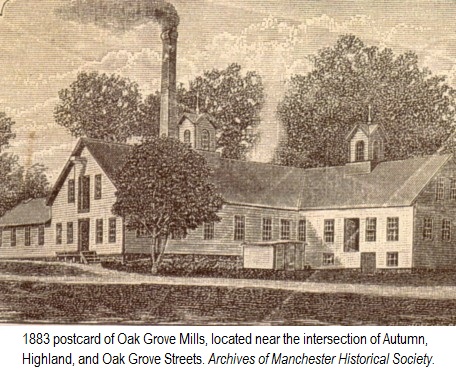
REPRINTS

Along New England's streams, countless mills used the flowing water for power, for washing impurities out of cloth, and
for dumping waste products. Manchester had many mills, long before 1823, when it incorporated as a town. In Lydallville,
Hilliardville, and Buckland, for example, mills were productive during the American Revolution.
 Oak Grove's mills date back into obscurity, although they are documented on an 1850 map of Manchester as "Paper Mill,"
on an 1855 map as "Globe Mills," and later as Oak Grove Paper Mills (see drawing, from a post card dated 1883). According
to Herb Bengtson, retired Town Historian, those mills burned in 1898.
Oak Grove's mills date back into obscurity, although they are documented on an 1850 map of Manchester as "Paper Mill,"
on an 1855 map as "Globe Mills," and later as Oak Grove Paper Mills (see drawing, from a post card dated 1883). According
to Herb Bengtson, retired Town Historian, those mills burned in 1898.
In addition to fire, floods caused destruction of our old mills. In the terrible storms of 1869, the only dam that
survived was Union Dam, in the North End. The rest burst and were washed away, along with many buildings.
By walking along the paths at today's Oak Grove Nature Center, an observer can recognize the mill pond, dug out to hold
water from Porter Brook to build up the necessary head of water for power. Evidence of the dam and various channels still
exists there, but no foundations or building remnants.
Juan Sanchez, Manchester Board of Education Professional Development Specialist for science education, has done
detective work on the site, finding evidence of the dam and the area from which earth was dug up to build the dam. He
recently surmised that the foundation of Oak Grove Mills may be located under the current parking lot of the Nature Center,
based on study of old maps, and on archeology digs conducted on this site over the years.
Older residents recall swimming and ice-skating in the pond during the 1940s and 1950s. Before metal bridges blocked
traffic into the water, residents used Porter Brook to wash cars, including Jeeps from the Armory on Main Street. In the
1960s, Manchester Jaycees' built the site's popular covered bridge, a miniature version of an authentic New England bridge,
sided with boards from tobacco sheds.
The Town of Manchester has owned the 53-acre tract since the 1950s, where Mr. Sanchez directed an environmental
education program from 1972 to 2004, teaching school children about science, nature, and ecology. During that time
thousands of children studied pond life, tapped maple trees, and learned about animal tracking. The Lutz Children's Museum
owns the nature-center building.
Today's Oak Grove is open year-round for hiking and observation of plants and wildlife. Visitors may park at the lot at
269 Oak Grove Street.